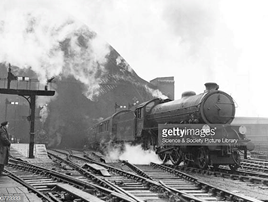He also set about simplifying Robertson’s complex management structure of ‘generals’, committees and sub-committees, opting to recruit private sector experts in a move to bring financial (as opposed to military) discipline to the Commission.
Further simplification came with the 1962 Transport Act, which abolished the BTC and established a British Railways Board (BRB), with powers to set passenger fares and more freedom with freight rates than hitherto.
Beeching became its first chairman on January 1 1963. Two months and countless cigars later, Her Majesty’s Stationery Office published The Reshaping of British Railways, which set out Beeching’s plan to put the railway ‘in the black’ by 1970.
History would show that the doctor’s remedies - the line closures, the focus on block freight workings, and so on - only managed to contain BR’s deficit. Furthermore, by 1968, the political landscape had changed such that Harold Wilson’s Labour government was seeking to support lines that were unprofitable, if they were socially desirable.
That year’s Transport Act - the fourth major piece of railway legislation since the war - therefore not only wiped out BR’s debt of £153 million, it also established Passenger Transport Executives (PTEs) in and around Greater Manchester, Glasgow, Merseyside, Tyneside and the West Midlands.
The idea was that the PTEs would co-ordinate local bus and rail services, ‘purchasing’ the latter from BR on a contract basis. Grants were also available for the ‘social’ railway, including £400,000 for Paddington-Oxford services, £2.5m for Glasgow North and South suburban services, and £9m for Southern Region commuter traffic.
All well and wonderful, but the tides ever do change, and within five or six years more new Whitehall brooms were seeking to reduce the subsidies provided to fund these loss-making services, and to cut the level of investment.
Regarding the latter, the BRB’s Annual Report for 1972 pointed out that “in terms of capital investment for renewal, research, development and improvement, the railways’ share has not been comparable with the millions poured into other forms of transport”.
New motorways and trunk roads, it went on, “represent a national investment every year more than five times greater than investment in British Rail, and even then most of the railway investment is to keep the system going”.
In 1974, another new Labour government brought in a new Railways Act which reduced BR’s capital debt from £438.7m to £250m and offered financial aid to businesses for setting up private sidings.
It also replaced the individual payments for passenger services brought in by the 1968 Act with one Public Service Obligation (PSO) grant. This was a vital step forward in the financial relationship between the railway and the Government, giving new security and self-respect to the management and helping to safeguard BR’s regional passenger business. Of course, it didn’t last, and by 1977 the Government had decided that the whole of the freight business and Inter-City should pay their way, even if other parts of the passenger business were to receive aid.
What might be deemed the ultimate solution had been hinted at after the 1979 General Election, at which Labour had been ousted by the Conservatives following a series of strikes over a public sector pay freeze imposed to control inflation.
Under the chairmanship of Sir Peter Parker, the BRB had realised that there would be little chance of Margaret Thatcher’s regime investing in rail unless something was done to increase productivity. With this in mind, that November it published Challenge of the ’80s, which outlined its aim to develop the railway’s commercial strengths, but also stressed the need to reform the operation and manning of trains, terminals and engineering establishments.
The upshot was that on January 4 1982, the railway’s commercial undertaking was divided into separate elements. Freight and parcels had always been seen as distinct entities, and these naturally formed two of the new sectors. On the passenger side, Inter-City was taken out first, after which London commuter services were grouped to form London & South East (later Network South East). Everything else became Other Provincial Services (later renamed Provincial, and later still Regional Railways). The last two were the ‘social railway’, requiring continuing support for the provision of socially essential services in the capital, in the great conurbations, and in rural areas.
Before this, the five Regions (the Eastern and North Eastern had become one in 1967) had been responsible for marketing, operations, engineering, finance, investment and personnel (as it was still called back then). The General Managers had control of these areas, although the fact that the markets served cut across the Regional boundaries meant that most of the financial responsibility resided with the Board.
Sector management would place managerial responsibility on one director, without changing the organisation unduly and without incurring crippling administration costs. Indeed, it would put BR on more of a business footing than even Beeching had envisaged, with each Sector responsible for sponsoring track, signalling and rolling stock investment, along with the modernisation of stations and so on.















Login to comment
Comments
No comments have been made yet.